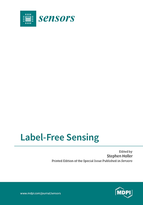Label-Free Sensing
A special issue of Sensors (ISSN 1424-8220). This special issue belongs to the section "Biosensors".
Deadline for manuscript submissions: closed (30 June 2015) | Viewed by 88306
Special Issue Editor
Interests: biological sensor development; environmental sensing; micro-optical sensors; whispering gallery mode biosensors; microcavity photonics; light scattering from bio-aerosols; fluorescence and absorption spectroscopy; cavity ringdown spectroscopy
Special Issues, Collections and Topics in MDPI journals
Special Issue Information
Dear Colleagues,
The implementation of label-free sensing of biological and chemical agents allows one to investigate the underlying physical and chemical characteristics and interactions target analytes while reducing both sample complexity and preparation time. Sensor platforms incorporating label-free detection schemes avoid the potentially confounding effects of molecular labels by monitoring the target species directly, relying solely on the intrinsic physicochemical properties of the target analyte. Because of the relatively minimal sample preparation, such approaches are well suited for field applications and remote diagnostics where either sample preparation facilities and/or trained personnel may be limited or unavailable.
Label-free detection schemes are becoming more robust and highly sensitive due to innovations in the field. These developments are opening doors to new applications and novel sensor designs. The result is a broad, interdisciplinary field that touches on many aspects of science and engineering. We seek to bring together the diversity of research and cross-pollinate ideas that would further enhance the field. To this end, we are soliciting manuscripts for a Special Issue focused on label-free detection and sensing of biological and chemical analytes, such as DNA, protein, bacteria, virus, toxic industrial materials, biological and/or chemical warfare agents, explosives, radionuclides, among others. Novel research that incorporate sensing modalities including, but not limited to, spectroscopy (absorption, fluorescence, Raman), photonics (fiber optic, interferometric, DFB, DBR), microcavities (spheres, toroids, ring resonators), plasmonic nanoparticle enhancement (spheres, shells, nanorods), micromechanical (QCM, cantilever), surface acoustic wave, surface plasmon resonance are welcome.
Dr. Stephen Holler
Guest Editor
Manuscript Submission Information
Manuscripts should be submitted online at www.mdpi.com by registering and logging in to this website. Once you are registered, click here to go to the submission form. Manuscripts can be submitted until the deadline. All submissions that pass pre-check are peer-reviewed. Accepted papers will be published continuously in the journal (as soon as accepted) and will be listed together on the special issue website. Research articles, review articles as well as short communications are invited. For planned papers, a title and short abstract (about 100 words) can be sent to the Editorial Office for announcement on this website.
Submitted manuscripts should not have been published previously, nor be under consideration for publication elsewhere (except conference proceedings papers). All manuscripts are thoroughly refereed through a single-blind peer-review process. A guide for authors and other relevant information for submission of manuscripts is available on the Instructions for Authors page. Sensors is an international peer-reviewed open access semimonthly journal published by MDPI.
Please visit the Instructions for Authors page before submitting a manuscript. The Article Processing Charge (APC) for publication in this open access journal is 2600 CHF (Swiss Francs). Submitted papers should be well formatted and use good English. Authors may use MDPI's English editing service prior to publication or during author revisions.
Keywords
- spectroscopy
- photonics
- microcavities
- plasmonics
- surface acoustic wave
- mechanical oscillators
- biosensors
- chemical sensors







